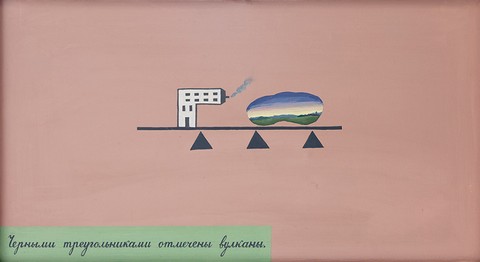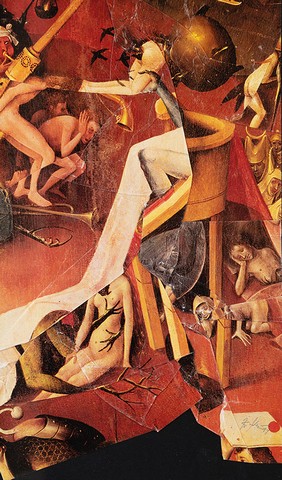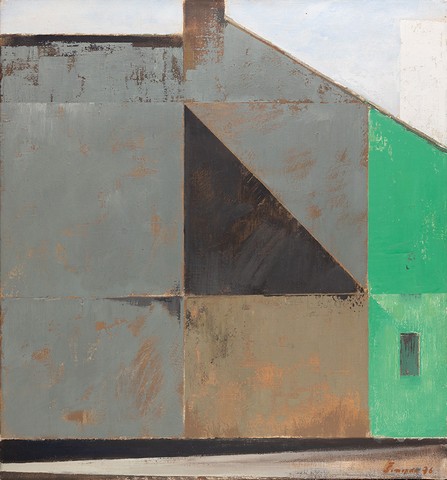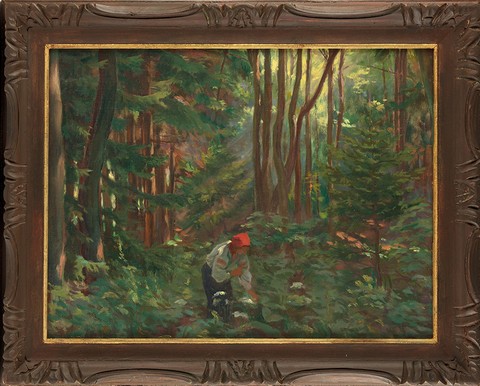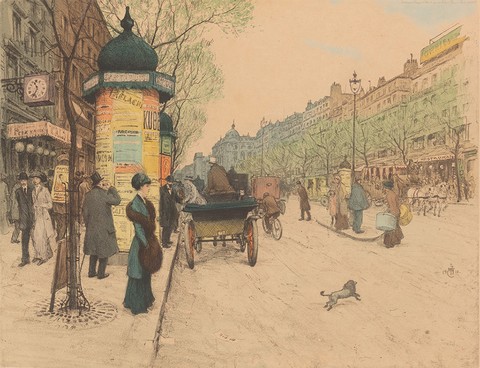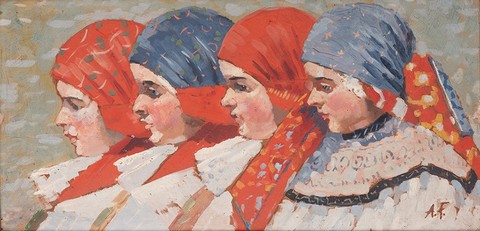Auction house
>
FINE ART
>
Untitled, 1992
‹ BACK
<<
>>
The offered painting from 1992 was made ten years after Viktor Pivovarov (b. 1937), a representative of the Moscow Conceptual School, moved to Prague and began a new phase of his life. The painting contains a number of elements, which are typical of Pivovarov and which recur in his work appear repeatedly. These include, for example, the mutually referential combination of image and text (the Cyrillic inscription notes that the black triangles indicate volcanoes), the use of geometric abstract elements, based on constructivist modernism and especially from the work of Kazimir Malevich, the use of isolated motifs, that are part of the permanent repertoire of Pivovar's work - in this case it is a house, grotesquely geometrically stylized with a smoking chimney that completes the view of the distant evening landscape seen through the lens of a telescope. The painting brings together several planes of different realities - abstract, illustrative, realistic and textual into a unique poetic whole, in which intertwines the artifice world with elements of everyday life. The painting represents Pivovarov's specific reality, a peculiar imaginative world in which a postmodern synthesis, combining conceptual starting points, the relationship of pictorial and textual record, book illustration, playful children's imagination and literary and artistic contexts. THE AESTHETICS OF THE SIGNBOARD OR THE OPEN IMAGE The protagonists of conceptualism in the West rejected the image as obsolete art form. The Russian conceptualists preserved the image for a number of reasons, albeit in a reformed form. It seems to me, I cannot say for sure, that the sololith and enamel paints for painting purposes were not used in this country before Kabakov. In any case, Russian conceptual painting began to make use of forms of street banners, i.e. the form of didactic informative or propaganda, non-art object. In the "House of Creation of Senezh", where we often worked in, they once appointed as director a former general in retired. The first thing he did when he took the job was to order the in various places with long quotations from recent resolutions of the Central Committee of the Communist Party of the Soviet Union and the speeches of the General Secretary. These boards appeared in the most unexpected places, not only in the interiors of the House of Creation, but but also, for example, by the lake or in the forest. Andrei Monastyrsky, who later, together with with the Collective Action group, put up a banner at the edge of the forest with the inscription "I'M NOT COMPLAINING ABOUT ANYTHING AND I LIKE EVERYTHING, ALTHOUGH I'VE NEVER BEEN HERE I HAVEN'T BEEN AND I DON'T KNOW ABOUT THESE PLACES", of course about the experiments of this avant-garde general. Personally, I was decisively influenced by the warning signs, which to this day can still be seen at railway stations around Moscow. I mean. the kind of banners that show a man crossing the tracks and rushing a train coming at him. The image is accompanied by the text, "What's more precious to you, your life or the money you save a minute " Sometimes, instead of a man with a briefcase, these signs show a man with a briefcase. and the text reads: "Don't cross the tracks!" In the varied genre variety of such warning signs, high quality was characterized by especially the ones against fire. One of these was particularly popular due to for its distinctive inscription in verse: The housekeeper was careless She left the iron on. And behold, what an unpleasant thing in the apartment afterwards. The image is always, even in a consciously flat conception, as in Mondrian, complex. interior space. The spatiality of the painting is completed by the frame, which creates the effect of a window behind which something is happening. The board, by contrast, is flat from the start, even though it shows a spatial object, it does not show what is BEHIND it, but what is ON it. A conceptual image that exploits the aesthetic qualities of such a of the board, is thus not turned inwards towards itself, but outwards, towards other images and to problems that do not directly concern the images. Thus an open image for which, apart from everything else, there is no binding frame. For the conceptual consciousness with its heightened attention to contextual links the open image, using the aesthetic qualities of panels, has become an important phenomenon. Viktor Pivovarov. Sonia and the Angels. Rudolfinum Gallery, Prague 1996.
Pivovarov Viktor *1937
Untitled, 1992
Signed on the reverse in Cyrillic V. Pivovarov, 1992 oil on canvas, 76 × 44 cm, frame Provenance: acquired by the owner from the artist's studio.The offered painting from 1992 was made ten years after Viktor Pivovarov (b. 1937), a representative of the Moscow Conceptual School, moved to Prague and began a new phase of his life. The painting contains a number of elements, which are typical of Pivovarov and which recur in his work appear repeatedly. These include, for example, the mutually referential combination of image and text (the Cyrillic inscription notes that the black triangles indicate volcanoes), the use of geometric abstract elements, based on constructivist modernism and especially from the work of Kazimir Malevich, the use of isolated motifs, that are part of the permanent repertoire of Pivovar's work - in this case it is a house, grotesquely geometrically stylized with a smoking chimney that completes the view of the distant evening landscape seen through the lens of a telescope. The painting brings together several planes of different realities - abstract, illustrative, realistic and textual into a unique poetic whole, in which intertwines the artifice world with elements of everyday life. The painting represents Pivovarov's specific reality, a peculiar imaginative world in which a postmodern synthesis, combining conceptual starting points, the relationship of pictorial and textual record, book illustration, playful children's imagination and literary and artistic contexts. THE AESTHETICS OF THE SIGNBOARD OR THE OPEN IMAGE The protagonists of conceptualism in the West rejected the image as obsolete art form. The Russian conceptualists preserved the image for a number of reasons, albeit in a reformed form. It seems to me, I cannot say for sure, that the sololith and enamel paints for painting purposes were not used in this country before Kabakov. In any case, Russian conceptual painting began to make use of forms of street banners, i.e. the form of didactic informative or propaganda, non-art object. In the "House of Creation of Senezh", where we often worked in, they once appointed as director a former general in retired. The first thing he did when he took the job was to order the in various places with long quotations from recent resolutions of the Central Committee of the Communist Party of the Soviet Union and the speeches of the General Secretary. These boards appeared in the most unexpected places, not only in the interiors of the House of Creation, but but also, for example, by the lake or in the forest. Andrei Monastyrsky, who later, together with with the Collective Action group, put up a banner at the edge of the forest with the inscription "I'M NOT COMPLAINING ABOUT ANYTHING AND I LIKE EVERYTHING, ALTHOUGH I'VE NEVER BEEN HERE I HAVEN'T BEEN AND I DON'T KNOW ABOUT THESE PLACES", of course about the experiments of this avant-garde general. Personally, I was decisively influenced by the warning signs, which to this day can still be seen at railway stations around Moscow. I mean. the kind of banners that show a man crossing the tracks and rushing a train coming at him. The image is accompanied by the text, "What's more precious to you, your life or the money you save a minute " Sometimes, instead of a man with a briefcase, these signs show a man with a briefcase. and the text reads: "Don't cross the tracks!" In the varied genre variety of such warning signs, high quality was characterized by especially the ones against fire. One of these was particularly popular due to for its distinctive inscription in verse: The housekeeper was careless She left the iron on. And behold, what an unpleasant thing in the apartment afterwards. The image is always, even in a consciously flat conception, as in Mondrian, complex. interior space. The spatiality of the painting is completed by the frame, which creates the effect of a window behind which something is happening. The board, by contrast, is flat from the start, even though it shows a spatial object, it does not show what is BEHIND it, but what is ON it. A conceptual image that exploits the aesthetic qualities of such a of the board, is thus not turned inwards towards itself, but outwards, towards other images and to problems that do not directly concern the images. Thus an open image for which, apart from everything else, there is no binding frame. For the conceptual consciousness with its heightened attention to contextual links the open image, using the aesthetic qualities of panels, has become an important phenomenon. Viktor Pivovarov. Sonia and the Angels. Rudolfinum Gallery, Prague 1996.
20
auction 66
starting price 360 000 CZK € 14 150
hammer price 550 000 CZK
starting price 360 000 CZK € 14 150
hammer price 550 000 CZK
Other items
cat. n.8
auction: 66
18 000 CZK / 707 €
starting price:
22 000 CZK
hammer price:
cat. n.9
auction: 66
24 000 CZK / 943 €
starting price:
24 000 CZK
hammer price:
cat. n.48
auction: 66
36 000 CZK / 1 415 €
starting price:
36 000 CZK
hammer price:
cat. n.112
auction: 66
14 000 CZK / 550 €
starting price:
14 000 CZK
hammer price:




